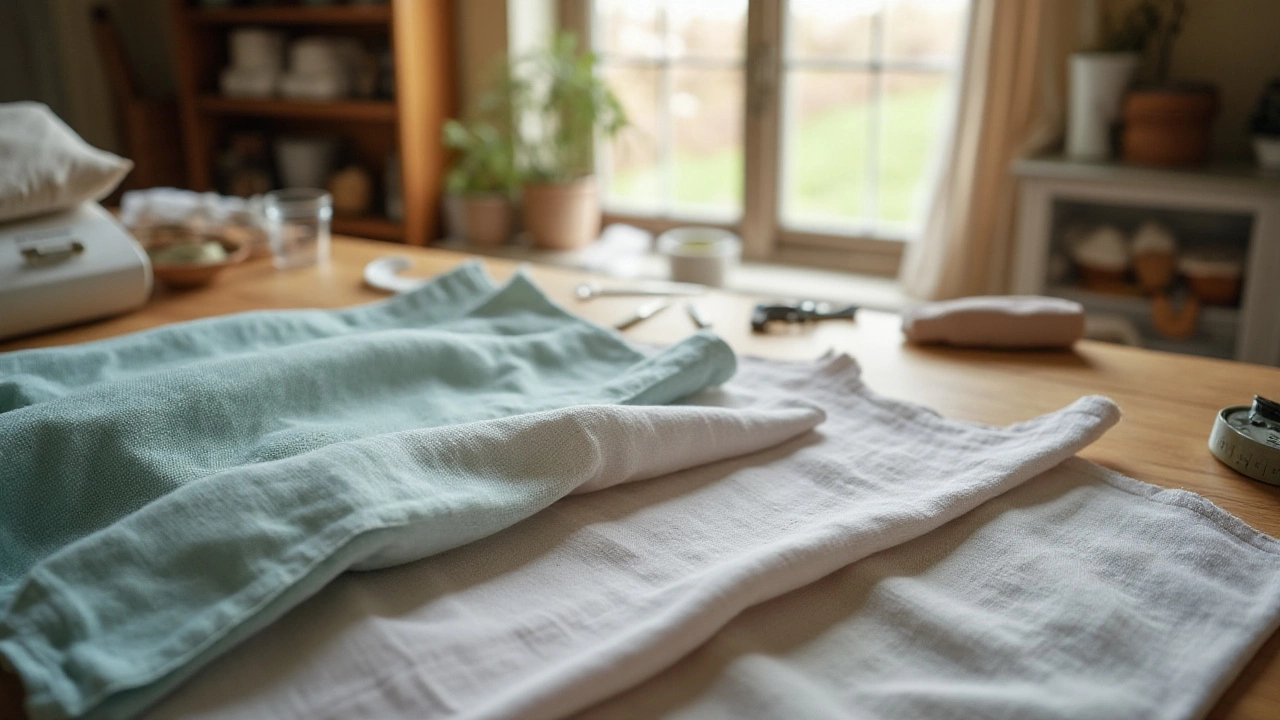Summer can be both a delight and a challenge when it comes to dressing. It's important to feel comfortable without sacrificing style. Whether you're attending a picnic in the park or lounging by the beach, choosing the right material for your dress is key. Some fabrics excel at keeping you cool under the blazing sun, allowing you to enjoy summer to the fullest.
In this article, we'll dive into the world of fabrics that keep you chill and stylish. From the classic comfort of cotton to the airy feel of linen, we'll uncover the secrets behind each material. Discover why some unexpected choices might just become your favorite go-to for those steamy days. Let's explore the art of fabric selection for your summer wardrobe.
- The Importance of Fabrics in Summer Wear
- Cotton: The King of Summer Fabrics
- Linen: Lightweight and Breezy
- Rayon: A Surprising Contender
- Tips for Choosing the Right Fabric
- Caring for Your Summer Dresses
The Importance of Fabrics in Summer Wear
When the sun is blazing overhead and the air feels thick with heat, the clothes we choose can make a world of difference in our comfort levels. In summer, summer fabrics are not just about aesthetics; they're about functionality. The right fabric can wick away sweat, allow air to circulate, and help regulate body temperature. This isn't just about looking good; it's about feeling good, too. The importance of choosing the right garment for the season cannot be understated, particularly because it can impact our daily activities and interactions. Imagine strolling through a bustling outdoor market with a gentle breeze softly cooling your skin, thanks to the right textile choice. That's the refreshing power of picking the perfect cool fabrics for your summer dresses.
Diving into the science of fabrics unveils why some materials help us stay comfortable in the heat. Natural fibers like cotton and linen are universally lauded for their breathability and moisture-wicking abilities. These fabrics possess unique properties that allow air to seep through easily, providing a cooling effect. Furthermore, they absorb moisture efficiently, drawing sweat away from the body and allowing it to evaporate quickly. This action helps in keeping the wearer dry and comfortable, even during the peak of summer heat. Fabrics with these characteristics are especially valuable for outdoor events like summer weddings or day-long excursions.
Then, there are fabrics like rayon, which, despite being less known, offer surprising benefits. Rayon, a semi-synthetic fiber, combines the lightweight quality of natural fibers with the durability of synthetics. It might not be the first fabric that comes to mind for summer wear, yet its ability to mimic the feel and texture of silk while remaining breathable makes it a hit among fashion aficionados. Incorporating lesser-known fibers into your summer wardrobe can provide a fresh twist, keeping your style both practical and fashion-forward.
"Choosing the right fabric is the foundation of staying comfortable and stylish in the summer," notes Clara Thompson, a fashion expert who advocates for season-appropriate wardrobe selections.
It's fascinating to note that fabric choices can also be influenced by cultural and regional preferences. In some parts of the world, airy muslins and gauzes are favored for their lightweight qualities and beautiful drape. In warmer climates, traditional garments often utilize locally sourced fabrics that have evolved to suit the weather conditions perfectly. These cultural insights are not only intriguing but also offer inspiration for our own wardrobes. Whether one opts for modern takes on classic styles or chooses traditional garments that have stood the test of time, understanding the role fabrics play in staying cool is crucial. Ensuring you are equipped with the knowledge of which fabrics excel under sweltering conditions can transform your summer experiences, allowing you to step out with confidence and ease.
Cotton: The King of Summer Fabrics
Cotton has long been hailed as the reigning champion in the realm of summer fabrics, and there's a good reason for it. Whether it's a light sundress or a casual tee, this natural material is a wardrobe staple when temperatures rise. Cotton's appeal largely stems from its breathability and moisture-wicking properties. Unlike synthetic fibers, which can trap heat, cotton allows air to circulate freely, ensuring your body stays cool. Its ability to absorb sweat and release it into the atmosphere is unparalleled, making it a perfect match for those sizzling summer months. Moreover, cotton is hypoallergenic, which means it's less likely to irritate sensitive skin, a bonus when heat-induced rashes are on the prowl.
Cotton's versatility doesn't end with its functionality; it also comes in a wide array of styles and textures, from the classic crisp cotton shirts to the softest cotton jersey. The fabric's adaptability means it can be seamlessly integrated into any fashion trend, allowing you to flaunt the latest styles while keeping your cool. Did you know that the ancient Egyptians were among the first to wear cotton clothing? The fabric's durability and comfort made it popular in their hot climate—facts that remain relevant today. Plus, cotton is relatively affordable compared to some luxury materials, making it accessible for all budgets.
The National Cotton Council of America once stated, "Cotton is the fabric of our lives." This couldn't be more accurate during those sweltering summer days. The breathability, versatility, and comfort of cotton have cemented its place in wardrobes across the globe.
When shopping for summer dresses, the weave of cotton is another factor worth considering. Loose weaves, like those found in lightweight cotton voile or batiste, let more air through. This quality makes these weaves perfect for casual attire and beachwear. In contrast, tighter weaves offer a bit more structure and are ideal for more formal summer events where you still want to stay cool without compromising on style. Cool fabrics like cotton muslin are particularly trendy among eco-conscious consumers due to their lower environmental impact compared to synthetic options. Recycling, composting, or repurposing old cotton garments is an added benefit, aligning seamlessly with sustainable fashion practices.

Linen: Lightweight and Breezy
Linen is a favorite summer fabric for many fashion enthusiasts for good reason. It's renowned for its lightness and ability to keep the body cool even during the hottest months. One of the key reasons linen is so popular in the summer is due to its ability to wick moisture away from the body. This property allows it to dry quickly, keeping you dry and comfortable. Linen is made from the fibers of the flax plant, which have natural cooling properties that make it ideal for hot weather. Its weave is typically loose, which permits air to flow easily through the fabric, creating an airy feel. The texture of linen is another notable feature: it's slightly rough but pleasing to the touch, lending a rustic charm to summer attire.
In terms of sustainability, linen is an eco-friendly fabric choice. The flax plant requires minimal water compared to other crops such as cotton, making it a more sustainable option. Moreover, every part of the flax plant is utilized, reducing waste. This contributes to linen's growing popularity among environmentally-conscious consumers who seek to reduce their carbon footprint with their fashion choices. According to a study published by the International Linen and Hemp Community, linen production emits 70% less carbon dioxide than cotton, and it is biodegradable, adding to its sustainable appeal.
Wearing linen does come with a few considerations. One of the most common issues people encounter is that linen wrinkles easily, which can either be a charming part of its character or a source of frustration, depending on the individual. Some embrace the relaxed look of a naturally wrinkled linen dress, while others prefer to frequently press their garments for a more polished appearance. It's important to note that many modern linen blends incorporate other fibers to reduce wrinkling while maintaining most of linen’s breathable properties. Both 100% linen and linen blends offer advantages that cater to different style preferences.
Linen is popular "not just for its cooling benefits," says sustainable fashion expert Lucy Siegle, "but also because it carries an effortless elegance that doesn’t try too hard." Embracing linen means embracing an easy-going, classic summer vibe.
Whether dressed up for an evening out or dressed down for a casual day at the beach, linen offers versatility that fits a variety of personal styles and settings. It comes in a range of natural and dyed colors, making it a versatile choice for anyone looking to expand their wardrobe with practical yet fashionable clothing items. For these reasons and more, linen remains an enduring staple in summer fashions around the world.
Rayon: A Surprising Contender
In the fashion world, rayon often stands as an unexpected yet delightful alternative when the summer heat is at its peak. Known for its exceptional ability to mimic the luxurious drape and softness of natural fibers, rayon is a man-made fabric derived primarily from wood pulp. This intriguing combination of natural and synthetic processes results in a fabric that is not only versatile but also exceptionally breathable. It's this unique blend that sets rayon apart when the mercury starts to rise, making it a favorite for summer dresses. Often, rayon is praised for its silk-like feel and its ability to keep the wearer cool and comfortable even in humid conditions.
Rayon has the added benefit of being moisture-absorbent. Unlike some synthetic fibers that trap heat and moisture, this fabric allows air to circulate freely, making it an ideal choice for those hot and sticky days. A lesser-known fact about rayon is its incredible adaptability; it can be crafted to mimic the texture and appearance of many different fabrics, such as cotton, silk, and linen. This chameleon-like quality broadens its appeal, especially for those seeking the sophisticated look of silk without the maintenance hassle and cost. Its adaptability is also a key reason why many designers incorporate it in their summer collections.
In a
study published in the Journal of Fashion Marketing, it was noted that rayon garments, especially those designed with vibrant summer patterns, have seen a 20% increase in consumer preference over the last decade.Many attribute this trend to rayon's effortless ability to blend functionality with style, making it an ideal choice for both casual and formal summer wear. The fabric's dyeing capability is another big win; it absorbs colors beautifully, ensuring that summer prints are both vivid and long-lasting. When exploring summer fashion, it's important to consider how colors and patterns interact with your summer lifestyle, and rayon provides the best of both worlds.
However, it’s essential to approach rayon with a bit of caution when it comes to care. Despite its many benefits, rayon can be prone to wrinkling and shrinking if not handled properly. Always pay close attention to care instructions, and consider hand washing or using the gentle cycle to preserve the life and quality of your rayon garments. For those truly passionate about their summer dresses, a little extra care goes a long way in maintaining their beauty and functionality season after season. Whether you’re planning a beachside escape or an evening garden party, rayon offers a chic solution that ensures you remain cool, comfortable, and effortlessly stylish.

Tips for Choosing the Right Fabric
Choosing the right fabric for summer dresses can be a fun and enlightening experience if you know what to look for. To start with, it's important to consider the breathability of the fabric. Fabrics that allow air to circulate naturally help to keep your body cool. Cotton, for example, is a beloved choice due to its ability to absorb moisture while remaining soft and comfortable against the skin. The way cotton fibers weave together creates small gaps that encourage airflow, a natural advantage during the hottest days of the year.
Then, there’s the weight and texture of the fabric to think about. Lighter fabrics tend to sit softly on the skin, a trait that's especially valued in summer dresses. Linen is a prime example here, as its lightweight nature and slightly crinkled texture not only add a relaxed vibe but also make it one of the most breathable materials. Be mindful, however, that a very dense weave, even in lightweight fabrics, might restrict airflow, so it's wise to opt for a fabric that seems to 'breathe' even if it’s lightweight.
Another point to consider is color and pattern. Light-colored fabrics reflect heat better than dark ones, which absorb it. This is why you often see summer collections dominated by whites and pastels. Prints and patterns can also play a role in heat regulation. Busy patterns might give you a perceived sense of warmth, while simpler patterns often feel cooler and more refreshing. In fact, studies have shown that lighter colors can dramatically reduce the temperature felt against your skin.
Durability is another key factor, especially if you plan on spending a lot of time outdoors. Fabrics like rayon, while being smooth and cool, might not last as long if exposed to repeated wash and wear in extreme heat. It's smart to weigh the importance of longevity against comfort for each specific occasion. Investing in a balance of durable and comfortable fabrics can ensure your wardrobe meets all summer needs.
"Good style is about finding great fabrics and colors you can live in." - Jenna Lyons, former executive creative director of J.Crew.
Lastly, you might want to think about sustainability. With more people aware of environmental impacts, choosing eco-friendly materials like organic cotton or bamboo can make a difference. Not only are these materials kind to the planet, but they’re also often kinder to the skin, free of harmful chemicals found in some synthetic options. Bear these considerations in mind and you'll find choosing the fabric for your summer dresses becomes an enjoyable and insightful part of your fashion journey.
Caring for Your Summer Dresses
When it comes to your summer dresses, treating them with a touch of gentleness can make a world of difference. Most fabrics that keep you cool, like cotton and linen, require specific care to maintain their delightful texture and vibrant colors. Start by checking the garment's label; it's the unsung hero that contains all the rules your dress lives by. Cool water is often your best friend, helping preserve the fabric's integrity while washing away the day's adventures. Avoid harsh detergents that can strip the fibers, and opt for something gentle, ensuring that your dresses survive more than just the summer.
While line drying sings a romantic tune of laundry flapping in the wind, it's also pragmatic. Direct sunlight might seem like a speedy solution, but it can fade colors quicker than you can say "heatwave." Instead, air dry your dresses in the shade or indoors to add years to their life. Remember, the iron is not a universal solution. Linen, while elegant and crisp, can take on a new persona with wrinkles. Iron on a low setting with steam to restore a smooth appearance, and for cotton, a warm iron should do the trick.
Stains can play the villain in your gorgeous summer narrative, but fear not. Most marks can be treated with a simple solution of water and a dab of vinegar; it's a tried-and-tested fix rooted in sustainability. But act swiftly, like a summer storm passes, to prevent blemishes from setting forever. If you're faced with more challenging stains, a dab of baking soda paste might just be the hero your wardrobe needs. In a world of fast fashion, caring for your clothes not only extends their lifespan but also contributes to a more mindful lifestyle. As a side note, consider your clothing storage carefully. Hanging your dresses is preferable, ensuring they remain crease-free and ready to wear at a moment's notice.
"Caring properly for your clothes means you don't have to replace them as often," says eco-friendly fashion advocate Sandy Black. "It benefits both your wallet and the environment."
One important aspect that often sneaks under the radar is when and how you choose to store your summer wardrobe as the seasons change. Before packing away your cherished dresses, ensure they're thoroughly clean. You wouldn't want any stray sunscreen or snack crumbs attracting unwelcome visitors. As temperatures drop, think about breathable garment bags. They keep your dresses ready for the next heatwave while allowing them to breathe. Fold them with a lavender sachet or cedar blocks to ward off pests and keep that fresh aroma intact.
In conclusion, a little attention to detail goes a long way in preserving your summer favorites. By investing time and care in your summer fabrics, you make a versatile collection that shines year after year. Just like how nature takes care to renew itself with each season, give your wardrobe that same love and patience. Whether you embrace the ritual as a personal reflection, or simply as a practical practice, remember: every small action counts in prolonging the life of your beloved summer attire.
